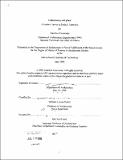Transparency and place : a visitors' center in Sydney Australia
Author(s)
Kourvaras, Vassilios
DownloadFull printable version (14.75Mb)
Alternative title
Visitors' center in Sydney Australia
Advisor
William Lyman Porter.
Terms of use
Metadata
Show full item recordAbstract
An exploratory design project is used as a vehicle to understand and identify approaches towards the notion of "place" and more precisely "visiting a place". The inquiry begins from the design challenge of an architectural competition for the design of a visitors' center in Sydney Australia. The international design competition set by AlA, ASCA and DuPont Glass Industry, is asking for a building, addressed to visitors of Sydney, that represents the "Australian culture" and can provide general information on ways to explore the continent. The design exploration navigates through several descriptions and approaches, on the city and the continent, conducted by a variety of intellectuals, writers, reporters, and Architects. The hints collected, enrich the design diary, and formulate the design process. "Transparency" is therefore used both as a means of looking through design as a tool of communication, research and representation, as well as a structural demand set by the competition. The design artifact navigates the design process towards the formulation of a specific proposal answering the primary demands; nevertheless in the research the focus is given on the experience of processing the design problem. Structured in a series of episodes, the design diary that follows, incorporates the research into a series of manifested notes on the issue of architectural conception. Diagrams and drawings representing several stages of the design evolution, are combined with the manifested theoretical points, and arguments in the form of parallel stories.
Description
Thesis (M.S.)--Massachusetts Institute of Technology, Dept. of Architecture, 1996. Includes bibliographical references (leaf 97).
Date issued
1996Department
Massachusetts Institute of Technology. Department of ArchitecturePublisher
Massachusetts Institute of Technology
Keywords
Architecture